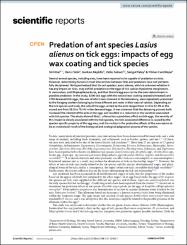| dc.contributor.author | Kar, Sirri | |
| dc.contributor.author | Şirin, Deniz | |
| dc.contributor.author | Akyıldız, Gürkan | |
| dc.contributor.author | Şakacı, Zafer | |
| dc.contributor.author | Talay, Şengül | |
| dc.contributor.author | Çamlıtepe, Yılmaz | |
| dc.date.accessioned | 2023-08-25T08:01:26Z | |
| dc.date.available | 2023-08-25T08:01:26Z | |
| dc.date.issued | 2022 | en_US |
| dc.identifier.issn | 2045-2322 | |
| dc.identifier.uri | https://doi.org/10.1038/s41598-022-19300-7 | |
| dc.identifier.uri | https://hdl.handle.net/20.500.12462/13302 | |
| dc.description | Şakacı, Zafer (Balikesir Author) | en_US |
| dc.description.abstract | Several animal species, including ants, have been reported to be capable of predation on ticks. However, determining factors in most interactions between ticks and predators have not yet been fully deciphered. We hypothesized that the ant species Lasius alienus, which is unknown whether it has any impact on ticks, may exhibit predation on the eggs of tick species Hyalomma marginatum, H. excavatum, and Rhipicephalus bursa, and that the tick egg wax can be the main determinant in possible predation. In the study, 6300 tick eggs with the natural wax coating (waxed/untreated) and 2700 dewaxed tick eggs, the wax of which was removed in the laboratory, were repeatedly presented to the foraging workers belonging to three different ant nests in their natural habitat. Depending on the tick species and trials, the rate of the eggs carried by the ants ranged from 12.8 to 52.1% in the waxed and from 59.8 to 78.4% in the dewaxed eggs. It was observed that the dewaxing process both increased the interest of the ants in the eggs and resulted in a reduction in the variation associated with tick species. This study showed that L. alienus has a predatory effect on tick eggs, the severity of this impact is closely associated with the tick species, the tick-associated difference is caused by the species-specific property of the egg wax, and the variety in the protective effects of the wax seems to be an evolutional result of the biological and ecological adaptation process of the species. | en_US |
| dc.language.iso | eng | en_US |
| dc.publisher | Nature Portfolio | en_US |
| dc.relation.isversionof | 10.1038/s41598-022-19300-7 | en_US |
| dc.rights | info:eu-repo/semantics/openAccess | en_US |
| dc.rights | Attribution 3.0 United States | * |
| dc.rights.uri | http://creativecommons.org/licenses/by/3.0/us/ | * |
| dc.subject | Cattle Tick | en_US |
| dc.subject | Acari | en_US |
| dc.subject | Pathogen | en_US |
| dc.subject | Ixodidae | en_US |
| dc.title | Predation of ant species Lasius alienus on tick eggs: impacts of egg wax coating and tick species | en_US |
| dc.type | article | en_US |
| dc.relation.journal | Scientific Reports | en_US |
| dc.contributor.department | Fen Edebiyat Fakültesi | en_US |
| dc.identifier.volume | 12 | en_US |
| dc.identifier.issue | 1 | en_US |
| dc.identifier.startpage | 1 | en_US |
| dc.identifier.endpage | 11 | en_US |
| dc.relation.publicationcategory | Makale - Uluslararası Hakemli Dergi - İdari Personel ve Öğrenci | en_US |




















